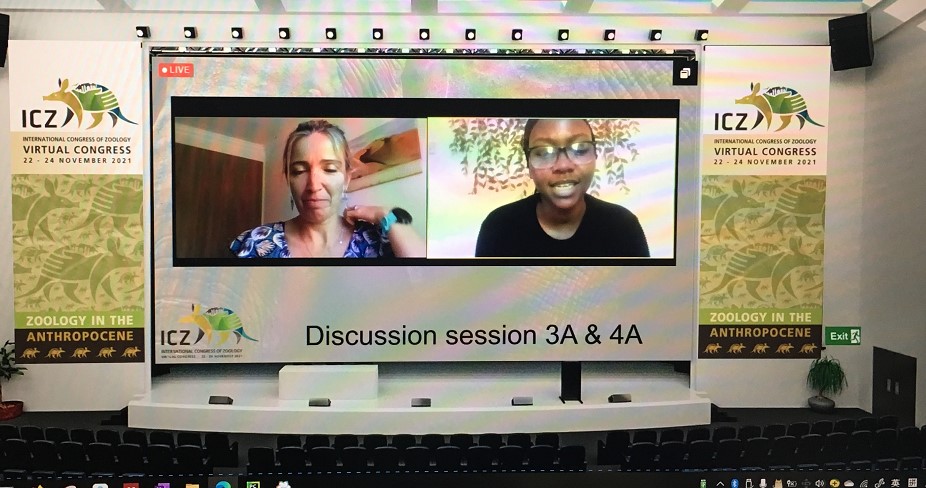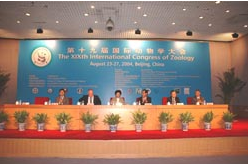Home > ACADEMIC > Academic Conference
On November 23, 2021, the 2nd IUBS/ISZS Virtual Symposium of Zoonotic Diseases was successfully held. The symposium was held within the subtheme “Conservation Ecology” of the scientific program “Zoology in the Anthropocene” of the 23rd International Zoological Congress. This conference was co-hosted by the International Union of Biological Sciences (IUBS) and the International Society of Zoological Sciences (ISZS) Working Group on Zoonotic Diseases. The symposium was supported by the Chinese National Committee of the International Union of Biological Sciences (CCIUBS), the University of Pretoria, South Africa, the Zoological Society of South Africa (ZSSA), the Institute of Zoology (IOZ), the Chinese Academy of Sciences (CAS) and the Chinese Association of Science and Technology (CAST). The purpose of this conference was to promote academic exchange in research on zoonotic diseases by scientists from different disciplines, and to reveal the ecological principles and dynamics of the spread of major zoonotic diseases that pose a high threat to humans.
The seminar invited four internationally renowned experts to give lectures, demonstrating the most cutting-edge research programs, progress, and results in related fields. Dr. Santiago Merino Rodriguez from the National Museum of Natural Sciences, Madrid, Spain gave a speech entitled "Biodiversity and Disease: From Theory to Facts". The report described the impact of humans on the ecosystem and the spread of diseases, and pointed out that the increase in the spread of zoonotic diseases is related to the loss of biodiversity caused by humans. The report also explained the impact of dilution and amplification effects on the spread of pathogens, pointing out that higher biodiversity can disperse the host (dilution) and reduce the spread of pathogens, and when the diversity of vector species increases (amplification), the risk of zoonotic disease transmission is instead increased.
Professor Hongxuan He from the Institute of Zoology, Chinese Academy of Sciences gave a report which describes the general situation of zoonotic in China. Through comprehensive research of more than 38,000 samples from wild animals throughout China, the results indicated that the risk of cross-species transmission is low with the bat coronaviruses. Avian influenza viruses may again cross species barriers to infect the human population and thereby initiate a new influenza pandemic. Contracaecum sp. infections in different sources from China, which might constitute a threat to wildlife, aquaculture, and public health.
Dr. Lei Xu from the School of Public Health of Tsinghua University gave a report entitled "Climate-driven plague dynamics the perspective from One Health". The report focuses on the history of the three plague pandemics, the damages caused to humans. The report pointed out that the plague is preserved in the natural foci (reserviors) in the natural environment, and climatic factors have a significant effect on driving the dynamics of plague in humans and animals, hence climate-driven plague dynamics. Climate affects the spread of plague among animal hosts, human epidemics, and the risk of spreading from natural reserviors to humans. The spread of plague during the third plague pandemic was also affected by climatic factors, geographical factors, and pathogenic genotypes. These phenomena remind us that the prevention and control of plague pandemics have always been a global problem. Pandemics repeatedly remind us: we should move forward, strengthen the surveillance of animal epidemics, and work to identify the potential foci (reservoirs) and host animals in order to prevent the animal disease spillover to humans. Such preventative measures may detect zoonotic diseases before they spread to humans and be done with little cost compared to the costs of medical treatments after human epidemics. In conclusion, the prevention, control and control strategies for the zoonotic diseases should be placed under the One Health concept, which refers to collaboration across disciplines, departments, and regions for the protection of human, animal and environmental health.
Professor Sergei Naidenko from the Severstov Institute of Ecology and Evolution of the Russian Academy of Sciences gave a report entitled "Zoonotic Diseases in Eastern Russia: the threat to Animals and Humans". The report describes the study of animal infections among felines and spread of infectious diseases in the “Land of Leopard” National Park and Ussurisky Nature Reserve in Russia from 2008 to 2021. The aim of the study was to estimate the occurrence of zoonotic pathogens in carnivores in the region of the Russian Far East. The study surveyed for 16 different pathogens based on their serum antibodies of 10 carnivorous species, including samples from 60 Amur tigers and 8 Amur leopards, along with more than 190 other mammals to determine their infection history. Studies have found that pseudorabies mainly occurs in tigers and bears, and many other pathogens are also mainly found in big cats and bears. The report concluded by pointing out that improving the education of local people is of great significance to reducing the risk of disease spreading from animals to humans.
More than 50 representatives from all over the world participated in this session, bringing together many experts, scholars and technicians at home and abroad who are engaged in the research and prevention and control of zoonotic diseases. Following the four reports, the participants raised questions and had discussions about the talks in the symposium. The participants actively engaged and discussed actively, exchanged academic ideas and shared their scientific research work.

